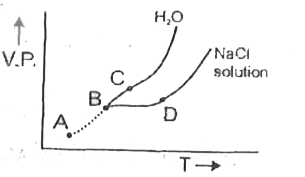During depression in the freezing point in a solution, the following are in equilibrium.
liquid solvent, solid solvent
liquid solvent, solid solute
liquid solute, solid solute
liquid solute, solid solvent
Freezing point of a substance is defined as the temperature at which the vapour pressure of its liquid form is equal to the vapour pressure of the corresponding solid. At this point, there is an equilibrium between solid and liquid states. If we cool a solution having a non-volatile solute to a temperature below the freezing point of solution, some of the liquid solvent will separate as a solid and due to this there will be an increase in concentration of the solution.
Topper's Solved these Questions
- BOOK - VMC MODULES ENGLISHCHAPTER - THEORY OF SOLUTIONSEXERCISE - JEE Main (Archive)57videos
THEORY OF SOLUTIONS
- BOOK - VMC MODULES ENGLISHCHAPTER - THE SOLID STATEEXERCISE - EXERCISE-J10videos
THE SOLID STATE
- BOOK - VMC MODULES ENGLISHCHAPTER - THERMOCHEMISTRYEXERCISE - JEE ADVANCED (ARCHIVE)31videos
THERMOCHEMISTRY
Similar Questions
During depression of freezing point in a solution, the following are in equilibrium:
View SolutionDuring depression of freezing point in a solution, the following are in equilibrium:
View SolutionDuring depression of freezing point in a solution, the following are in equilibrium:
View SolutionDuring depression of freezing point in a solution, the following are in equilibrium:
View SolutionAt freezing point of a solution there is always
View SolutionDepression in freezing point of solution of electrolytes are generally
View SolutionThe depression in freezing point is maximum if the solvent used is
View SolutionSolution with highest freezing point is
View Solution
Freezing point of solution is marked asView SolutionElevation in the boiling point for 1 molal solution of glucose is 2K. The depression in the freezing point for 2 molal solution of glucose in the same solvent is 2K. The relation between KbandKf is
View Solution

